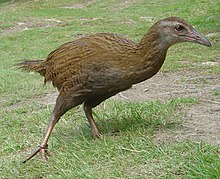Wekaralle
| Wekaralle | ||||||||||
|---|---|---|---|---|---|---|---|---|---|---|

Wekaralle ( Gallirallus australis ) |
||||||||||
| Systematics | ||||||||||
|
||||||||||
| Scientific name | ||||||||||
| Gallirallus australis | ||||||||||
| ( Sparrman , 1786) |
The Wekaralle ( Gallirallus australis ) is a New Zealand species of bird from the family of the walleye (Rallidae). It is a large species of rail, significantly larger than the common rail rail that is widespread in Southeast Asia, Australia and New Zealand .
The population of the flightless Wekaralle is indicated as endangered ( vulnerable ). There are four subspecies.
features
The 50 cm long and between 520 grams and 1.4 kg heavy Wekaralle is a flightless bird with very small wings and short, stocky legs. The plumage, which is brown on top and greyish on the underside, is dark marbled. The gender dimorphism is not very pronounced. Females tend to be slightly smaller with lighter bills and pale pink to orange-brown legs and feet.
Occurrence
The Wekaralle lives in the bush, on the edges of forests and in the grasslands of New Zealand. The main habitat of the Wekaralle are southeastern areas of the South Island of New Zealand. The individual subspecies occur in the following regions:
- G. a. greyi (Buller, 1888) - North Island of New Zealand
- G. a. australis (Sparrman, 1786) - north and west of the South Island of New Zealand.
- G. a. hectori (FW Hutton, 1874) - originally the east coast and inland areas of New Zealand's South Island. However, it is now extinct there. It only occurs on the chatham islands , where it was introduced.
- G. a. scotti (Ogilvie-Grant, 1905) - Stewart Island , the third largest island in New Zealand . It joins the New Zealand South Island 30 km south . Their area is 1680 km².
The Wekaralle is a resident bird . The greatest distances that Wekarallen covered according to current knowledge were 9 kilometers for a subadult young bird and 15 kilometers for an adult male. Both birds crossed larger rivers and larger lakes during their migration. Apart from these documented individual cases, fully grown Wekarallen stay in a fixed area all year round. As soon as subadult Wekarallen separate from their parent birds and leave the parental territory, they try to establish their own territory as quickly as possible. The young birds are dispersed in two phases: In the first phase, the young birds stay in a zone immediately adjacent to their parents' territory. The second phase then takes place within the next four months, in which the young birds move away until they can establish their own territory in a suitable area. Usually they don't move more than 5 kilometers. Most of the new territories are established at a distance of 1.3 kilometers from the parents' territory.
food
The Wekaralle is a diurnal and nocturnal bird. It is an opportunistic omnivore, whose diet includes seeds, fruits, bird eggs, carrion, invertebrates, and small vertebrates. For example, the Wekaralle on the South Island of New Zealand is one of the main predators of the thick-billed penguin . It mainly eats the young birds and eggs. Usually, however, it searches for food with its beak in the layer of leaves on the ground. She does not use her feet while searching for food.
Way of life
If the situation calls for it, the Wekaralle can run fast and swim just as well. While the subspecies that live on the North Island are considered shy, the one on the South Island is described as curious.
The Wekaralle can breed all year round, so that a hen can produce up to four clutches during this period. The main breeding season, however, is between August and February. In a shallow shell nest made of sedges and grass between herbaceous plants and dead branches, both parent birds incubate up to six eggs alternately.
literature
- PJ Higgins (Ed.): Handbook of Australian, New Zealand & Antarctic Birds. Volume 2: Raptors to Lapwings. Oxford University Press, Oxford 1993, ISBN 0-19-553069-1 .
- Colin Harrison, Alan Greensmith: Birds: with more than 800 species. Dorling Kindersly Limited, Starnberg 2005, ISBN 978-3-8310-0785-1 .
- Bryan Richard: Birds: over 400 species from around the world. Parragon, Bath 2006, ISBN 978-1-4054-5506-0 .
Web links
- Gallirallus australis in the endangered Red List species the IUCN 2008. Posted by: BirdLife International, 2006. Retrieved on January 4 of 2009.
- Videos, photos and sound recordings on Gallirallus australis in the Internet Bird Collection
Single receipts
- ↑ Handbook of the Birds of the World zur Bindenralle accessed on May 28, 2017.
- ↑ Higgins (Ed.): Handbook of Australian, New Zealand & Antarctic Birds. Volume 2, p. 506.
- ↑ Higgins (Ed.): Handbook of Australian, New Zealand & Antarctic Birds. Volume 2, p. 507.
- ↑ Higgins (Ed.): Handbook of Australian, New Zealand & Antarctic Birds. Volume 2, p. 508.
- ↑ a b Higgins (Ed.): Handbook of Australian, New Zealand & Antarctic Birds. Volume 2, p. 509.
- ↑ Tony D. Williams: The Penguins. Oxford University Press, Oxford 1995, ISBN 0-19854-667-X , p. 196.

